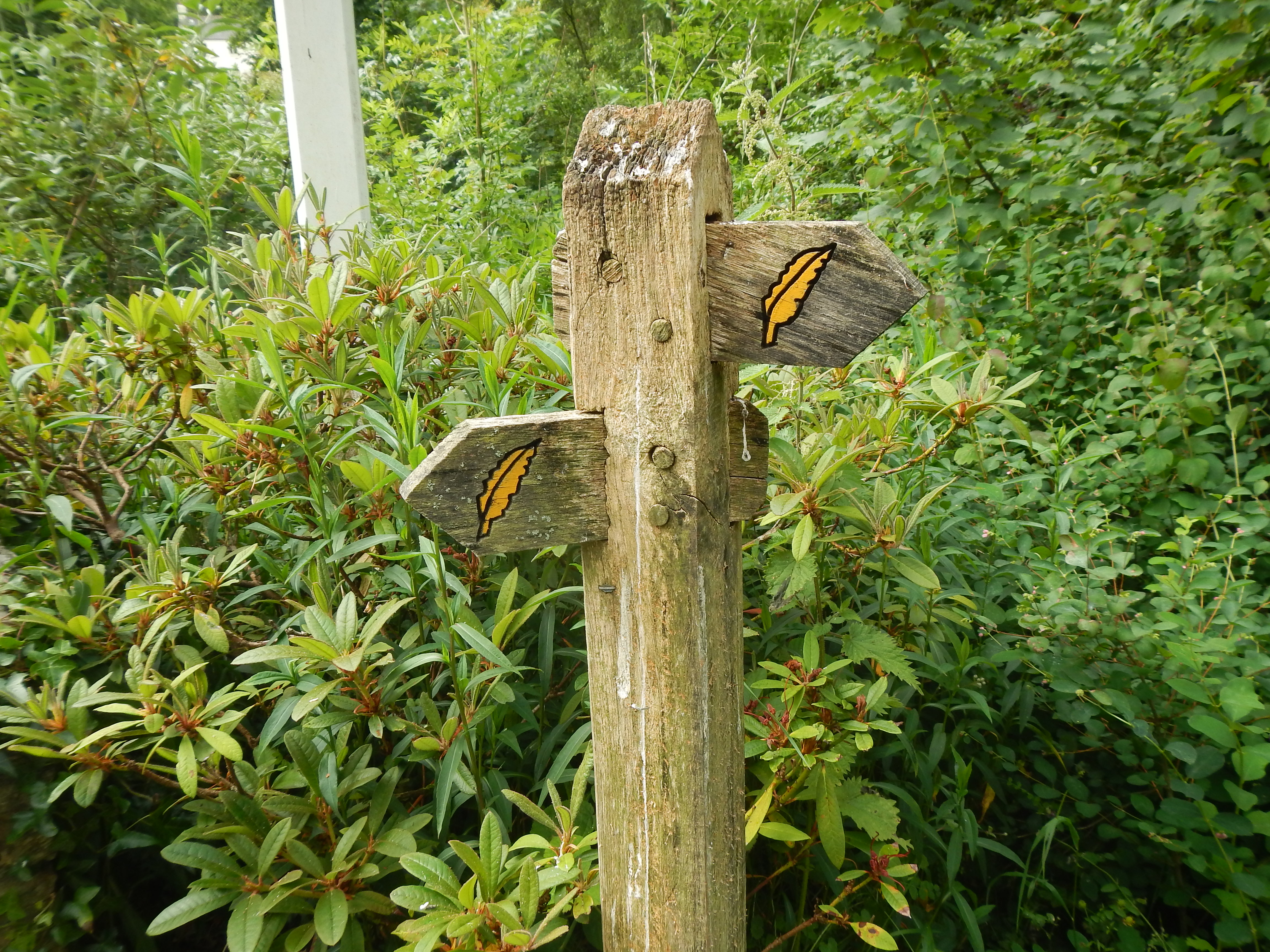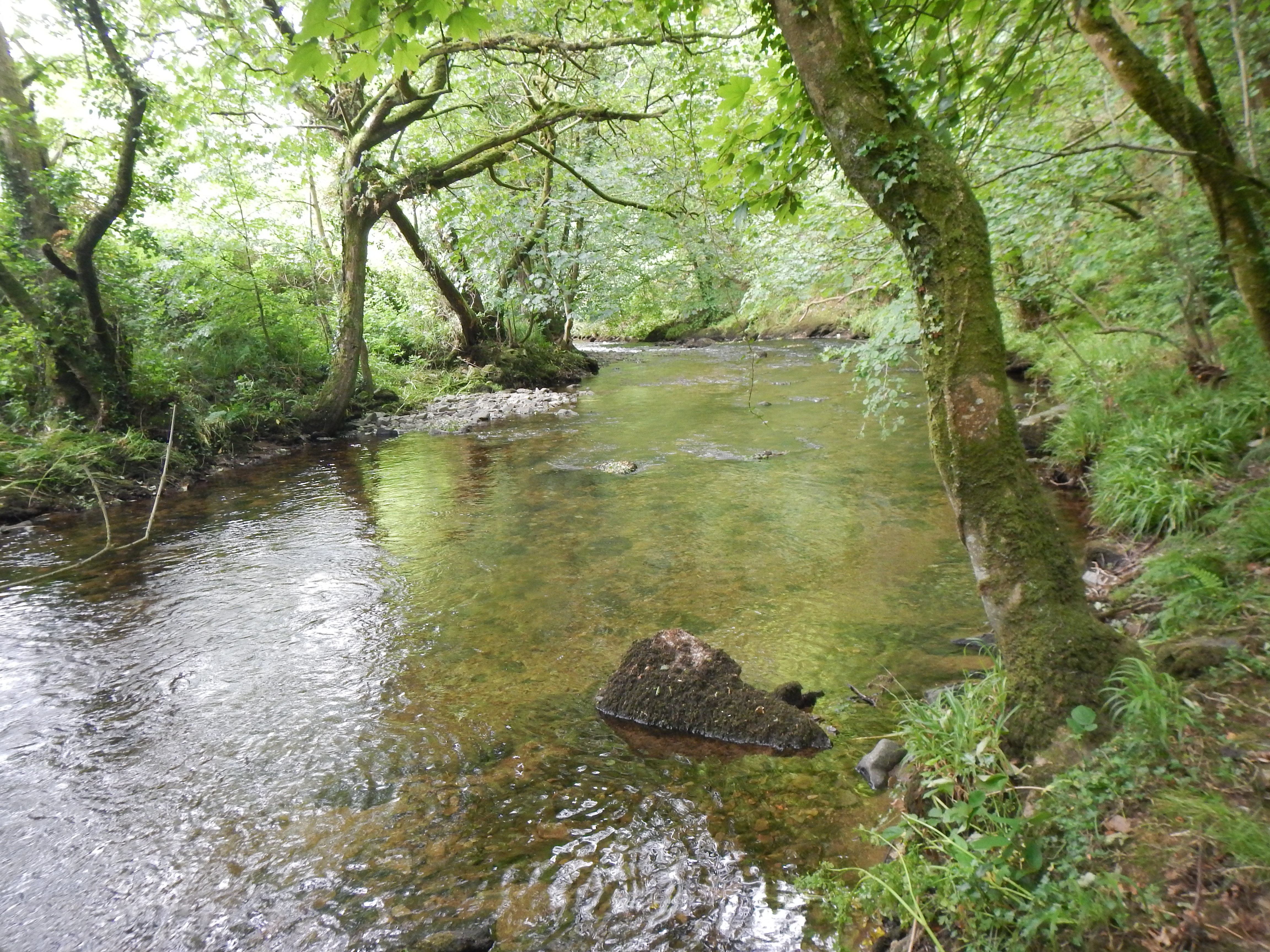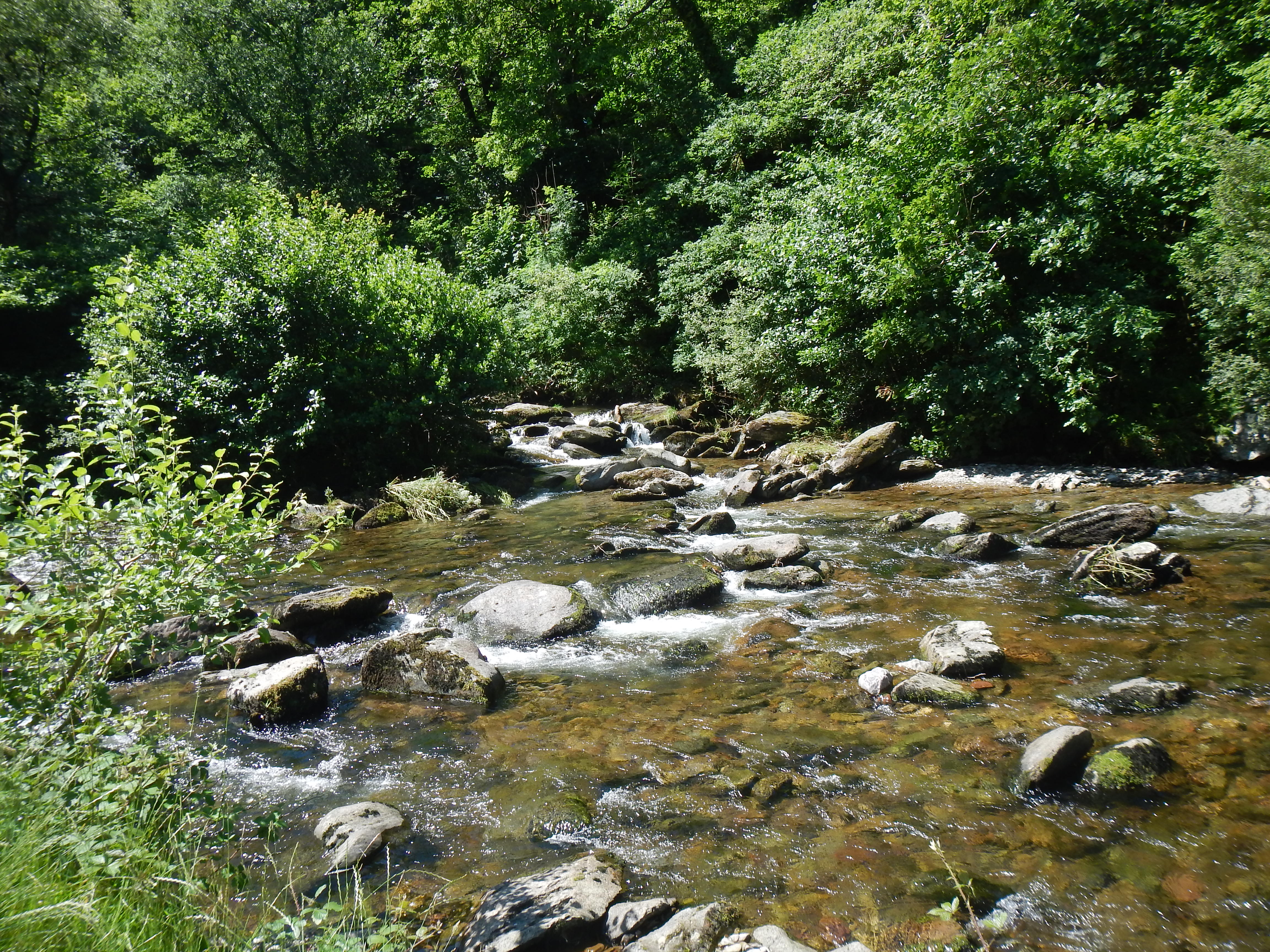July 1, 2019: Brendon to Lynmouth
We did not need to worry about lunch materials on this last day of our walk on the Coleridge Way – for we had concluded that we should be able to reach our ultimate destination in Lynmouth in time for a noonday meal. I suppose one could say that there was another unique aspect to this day’s stage – we planned to complete every step of the CW route without variation. (Of course, Lynmouth is only five miles or so from Brendon.)
We enjoyed our breakfast at Millslade Country House at 8:30 or so – when it was necessary to ask for more of Simon’s home-baked sourdough toast. (At such meals Adrian always experimented with exotic jams and preserves – like whortleberry.) We left the house at 9:35, checking first to see that the free range chickens had all survived the road traffic, but our time on tarmac would be limited today. We walked back to the center of the village, took a left, reached more flower-bedecked cottages and located a track that we could follow in a south-westerly direction. Several farmsteads were passed and then we were on footpath – with the bubbling East Lyn river our constant companion on the left.
I have to say that this stretch between Brendon and Watersmeet was like walking in paradise – with wildflowers at our feet, tall trees overhead and the sparkling river below. After a while the river made a northerly turn and, of course, we did as well. At this moment there was no one else about but eventually a couple with a noisy Jack Russell crossed a bridge from Rockford across the river and we soon lost sight of them – though we often heard the dog ahead of us.
Adrian had discovered that the National Trust maintains a teahouse at Watersmeet and, with more and more people about, we reached this spot and sat down for some refreshments. I drank a Diet Pepsi; Adrian ate a bun. I was puzzled by one thing – we had yet to see any meeting of the waters, that is the confluence of the East Lyn with a new stream – one that combined the contributions of Farley Water and Hoar Oak Water – and I was not going to leave this spot without doing so. In the event the famous meeting point was only a few yards ahead of us, as we got up to make our departure, and it was not that exciting after all.
I had never been to Watersmeet but I knew Hoar Oak Water for near the Hoar Oak Tree in 1992 Gavan and I had to make a crossing as we completed the last stages of the nearby Two Moors Way. (Gavan had crawled across on an old weir; I had gone upstream a bit and found a narrowing of the water that I could leap across.)
Gradually we left the trippers behind as we resumed our march on the still wonderful footpath. It rose and fell a bit more now but it was still very comfortable walking. We passed a tree trunk in which people had embedded standing coins – perhaps hoping for good luck in a gesture parallel to that undertaken by visitors to the Trevi Fountain in Rome. (The Trevi trunk?) Spanning the river was a wire decorated with suspended footwear. In urban America this would have advertised the proximity of local drug dealers but I have no idea what it meant here.
On our right there were several steep paths that offered turnoffs to the village of Countisbury. One group of geriatric walkers was climbing down to our path on one of these. They all had sticks and I suspect that many of them used these useful objects all the time. My own walking stick, incidentally, was new – I had been forced by its decrepitude to replace my old and loyal version of this walking companion only recently. It had been used by Dorothy is the last weeks of her life and I had treasured it for this reason alone.
Countisbury, incidentally, is on the South West Way and I well remember our walking party, one that included Dorothy, the Lees and our Michigan friend, Janet, arriving here after a very strenuous second day on this route. An exhausted Janet had approaches a surprised chap working on his car and said, “How much would you charge if you were to drive me to Lynmouth?” He charged two pounds.
Soon enough we were approaching the first outbuildings of Lynmouth itself and our route on Tors Road brought us directly past the front porch of our final b&b, yes, Lorna Doone House. It was 1:30 and there was no one at home so we continued onward, using a bridge to cross the culvert-captured river, and penetrating the tourist-clogged town – which I had twice visited before on the aforementioned expeditions. We marched all the way to the coast and celebrated the end of our walk with a number of photos.
Adrian had located a café around the corner and here we sat down for some nice crabmeat sandwiches. I was having trouble getting a signal on my iPhone and I did want to make contact with a taxi that could take us to the Barnstaple train station on the following morning. As on so many other occasions we were helped in this matter by a kind stranger. In this case it was the proprietor of the café. She knew Neil, the driver recommended by Celtic Trails, and reached him for me on her phone. In this fashion I was able to book a cab for 10:30 the next morning.
There was still no answer on the phone at our guesthouse and, while Naomi and Adrian headed off to visit the Valley of the Rocks (which I had seen in 1987), I entered the nearby Rising Sun pub, recommended by our benefactor, and here I nursed half a lager for the better part of an hour. Then, taking the last pictures of the passing scene, I strolled back to Lorna Doone House at 4:00 and this time I was admitted by Russell. He led me up two flights of stairs to my room and here I rested for an hour before the return of my in-laws.
When we set out for our evening meal the town was all but deserted by the day-trippers. The restaurant of the Ancient Mariner was full up, it seemed, but they shoved two tables together and we had a very nice meal. It was somehow fitting that our first meal had been in Nether Stowey’s Ancient Mariner.
I tried to put all my things in order as I packed the next morning, one we took at a leisurely pace since we did not expect Neil until 10:30. The ride to Barnstaple reminded my strongly of so many of the sites I had visited while doing the South West Way. Neil kept up a running commentary, naturally, and he confirmed something that I remembered from earlier visits to Barnstaple – that the place was notoriously famous for traffic jams. Today, new traffic circles in place, there was plenty of time in hand and, as I had purchased tickets on the 11:43 train to Exeter St. Davids, we had time to have another coffee in the station café.
The shuttle made many stops in a journey that took a little over an hour. I had made this same trip many a time in the past. At Exeter we had fifteen minutes to change trains before climbing aboard the 13:02 – where we had seat reservations in Car A. In fact these were occupied by a young lady with a laptop but there was plenty of room for all – though no room for Adrian’s suitcase. (My own wheel-less carryall easily fit into an overhead shelf – a point I couldn’t help noting for I was always being chided for not using wheels myself.)
After we had been on the train for an hour or so an announcement was made – another passenger was ill and if there was a doctor aboard could he or she come forward now. In fact it was decided that medical assistance was needed at the next stop, Reading, and since it hadn’t arrived when we did passengers were advised to abandon this train and take another to Paddington. This we did, using lifts, and we did not have long to wait – arriving at our final destination only ten or so minutes later than scheduled.
I am not sure that, with delays coming and going, our visitors were that impressed with the nation’s train service but in other ways we were all very pleased with our expedition on The Coleridge Way.
Footpath Index:
England: A Chilterns Hundred | The Chiltern Way | The Cleveland Way | The Coast-to-Coast Path | The Coleridge Way | The Cotswold Way | The Cumberland Way | The Cumbria Way | The Dales Way | The Furness Way | The Green London Way | The Greensand Way | The Isle of Wight Coast Path | The London Countryway | The London Outer Orbital Path | The Norfolk Coast Path | The North Downs Way | The Northumberland Coast Path | The Peddars Way | The Pennine Way | The Ridgeway Path | The Roman Way | The Saxon Shore Way | The South Downs Way | The South West Coast Path | The Thames Path | The Two Moors Way | The Vanguard Way | The Wealdway | The Westmorland Way | The White Peak Way | The Yorkshire Wolds Way
Ireland: The Dingle Way | The Wicklow Way
Scotland: The Great Glen Way | The Rob Roy Way | The Speyside Way | The West Highland Way
Wales: Glyndwr’s Way | Offa’s Dyke Path
Channel Islands: The Guernsey Coastal Walk | The Jersey Coastal Walk



